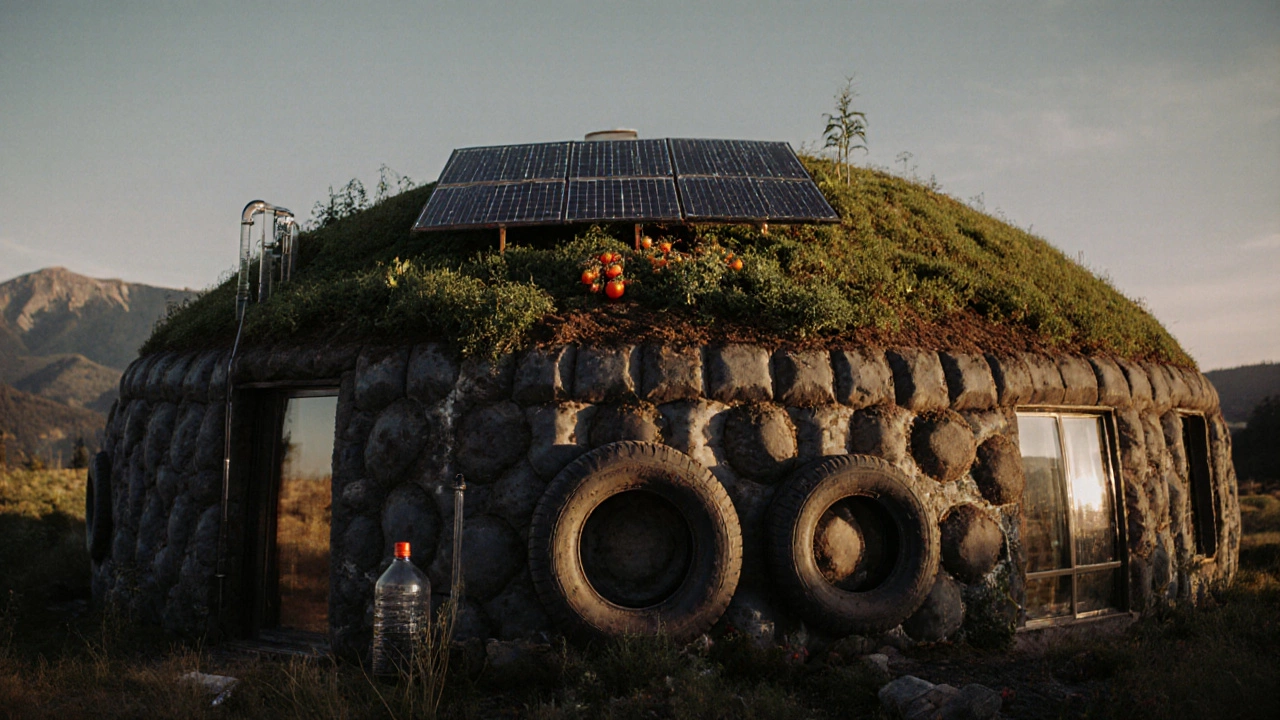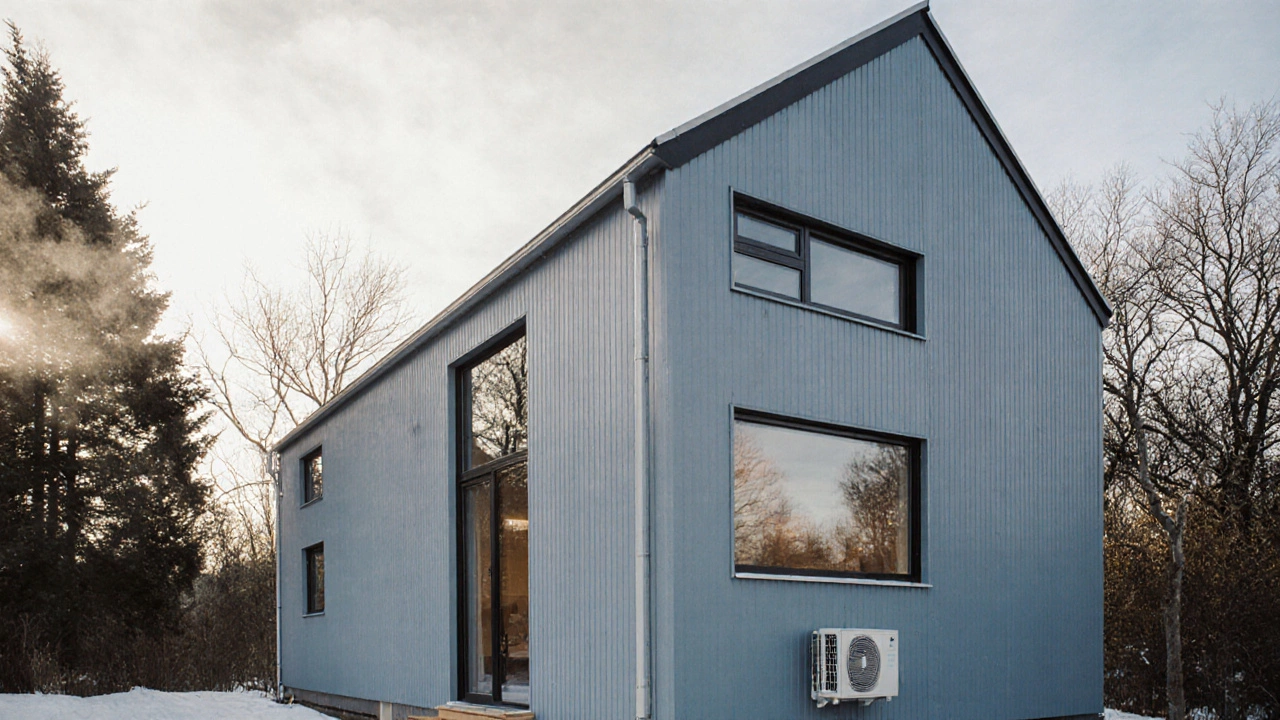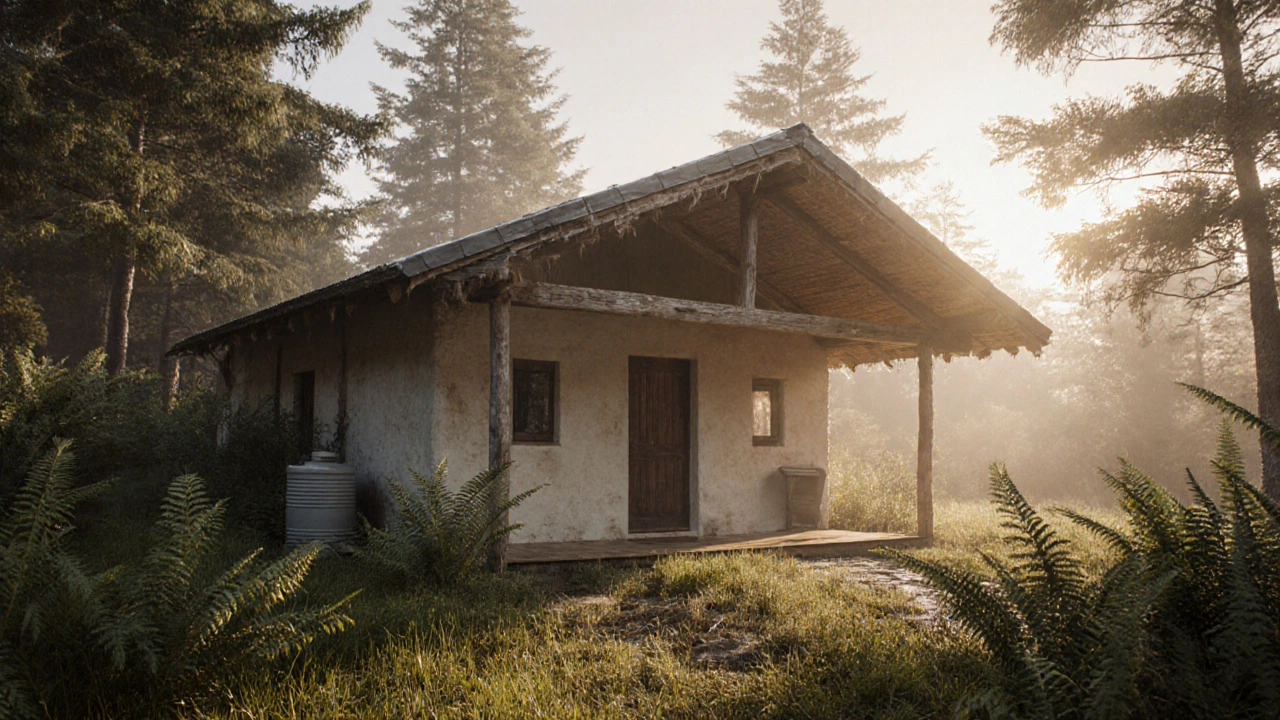Green Home Energy Calculator
Compare Sustainable Housing Options
Estimated Energy Savings
The most environmentally friendly type of housing isn’t a fancy smart home with solar panels glued to every surface. It’s the quiet, simple, low-impact home that blends into the land instead of fighting it. In places like Devonport, where rain comes often and the air smells like salt and pine, the best green homes aren’t the most high-tech-they’re the ones built with local materials, designed for the climate, and lived in with care.
Straw Bale Homes: Built Like a Nest
Straw bale homes might look like something out of a fairy tale, but they’re one of the most proven green building methods in the world. Straw, a byproduct of grain farming, gets compressed into thick walls that act like natural insulation. These walls can have an R-value of 40 or higher-more than double what most modern houses use. In winter, they hold heat in. In summer, they keep it out. No HVAC system needed.
They’re not new. Farmers in Nebraska built them in the 1890s when wood was scarce. Today, they’re making a comeback. A 2023 study by the University of California found straw bale homes used 75% less energy for heating and cooling than standard stick-built homes. And because straw is renewable and biodegradable, when the house is retired, it returns to the earth without leaving toxic waste.
The catch? Moisture control is everything. If water gets trapped in the walls, mold follows. That’s why they’re always built with wide overhangs, breathable plaster finishes, and raised foundations. Done right, they last over 100 years.
Earthships: Homes That Grow Their Own Food
Earthships are the ultimate off-grid experiment. Made from recycled tires packed with dirt, glass bottles, and reclaimed wood, they’re designed to be self-sufficient. Solar panels power lights and pumps. Rainwater is collected from the roof, filtered through planters, and reused for flushing toilets. Greywater from sinks feeds indoor gardens where you can grow tomatoes, herbs, and lettuce year-round.
They’re not for everyone. The curved walls and thick thermal mass mean they take time to heat up and cool down. But in places with long, cold winters and hot summers-like the Pacific Northwest or parts of New Zealand-they work brilliantly. A 2024 report from the Earthship Biotecture team showed residents of Earthships in Taos, New Mexico, used 90% less grid electricity and 100% less municipal water than their neighbors.
They’re labor-intensive to build, which keeps costs down but requires sweat equity. If you’re willing to learn how to tamp dirt into tires and install passive solar windows, you’re not just building a house-you’re building a closed-loop ecosystem.
Passive House: The Science of Comfort
If you like your house to be warm in winter and cool in summer without touching a thermostat, the Passive House standard is your best bet. It’s not a style-it’s a performance benchmark. To qualify, a home must use no more than 15 kWh per square meter per year for heating and cooling. That’s about 10% of what a typical New Zealand house uses.
How? Super-thick insulation, airtight construction, triple-glazed windows, and a heat recovery ventilation system that pulls in fresh air while keeping the heat inside. It’s not magic. It’s math. And it works even in damp, windy places like Devonport.
A 2025 survey of Passive House homes across New Zealand found residents paid an average of $280 a year for heating and cooling. That’s less than most people pay for Netflix. The upfront cost is 10-15% higher than a standard build, but the payback happens in 7-10 years through energy savings. Plus, the air inside never feels stale. People with allergies often report fewer symptoms.

Reclaimed Timber and Local Stone: The Quiet Heroes
Even the fanciest green home can fail if it’s built with materials shipped halfway across the world. The carbon cost of transporting steel, concrete, or imported timber can wipe out all the energy savings from solar panels.
The smartest green homes use what’s already here. Reclaimed timber from old barns, factories, or wharves. Local stone quarried within 50 kilometers. Bamboo, which grows three feet a day and needs no pesticides. In New Zealand, many builders now source kauri or totara from deconstructed heritage buildings. Not only does this save trees, it gives the house a story.
A 2024 study by the New Zealand Green Building Council found homes using locally sourced materials reduced their embodied carbon by up to 60% compared to those using imported products. Embodied carbon is the emissions tied to making and moving materials-it’s the hidden cost most people forget.
Small Is the New Green
The most sustainable house is the one you don’t need to build. But if you must, make it small. A 60-square-meter cottage uses less material, less energy, and less money than a 200-square-meter house. It’s easier to heat, easier to clean, and easier to maintain.
Look at the tiny house movement in New Zealand. In 2023, over 1,200 tiny homes were registered nationwide. Many are built on trailers, so they can move with the seasons or be relocated if needed. Some are used as guest houses. Others are full-time homes for retirees, remote workers, or young families.
Small homes don’t mean sacrificing comfort. A well-designed 40-square-meter space with high ceilings, large windows, and smart storage can feel bigger than a poorly laid-out 100-square-meter house. The key is intention. Every inch matters.

What to Avoid
Not every “green” label is real. Watch out for these traps:
- Greenwashed solar panels: Cheap panels made in factories with poor labor and high emissions. Look for panels with Cradle to Cradle or Energy Star certification.
- Recycled plastic decking: Made from ocean plastic? Sounds great. But many are coated in toxic sealants and can’t be recycled again. Stick to FSC-certified wood or bamboo.
- Overbuilt insulation: Thicker isn’t always better. Too much insulation in a humid climate can trap moisture. Work with a local builder who knows your region’s weather patterns.
- Big solar arrays on tiny homes: If your home uses 500 kWh a year, you don’t need a 10 kW system. Oversizing wastes money and creates e-waste later.
Real Examples in New Zealand
In the Bay of Islands, a straw bale cottage built in 2022 uses no grid power. Rainwater is collected in a 15,000-liter tank. Composting toilets handle waste. The walls are plastered with lime and clay from a nearby farm. The owner pays $0 for utilities.
In Nelson, a Passive House built in 2024 has a 9.8 kW solar array-but only because the occupants run a home-based business. The house itself uses 80% less energy than the average New Zealand home. The family says they’ve never felt colder in winter or hotter in summer.
These aren’t fringe experiments. They’re proof that the best green homes aren’t the loudest. They’re the ones that listen-to the land, the weather, and the resources already around them.
Where to Start
If you’re thinking about building or buying a green home:
- Start small. A 50-square-meter cottage is easier to make truly green than a 300-square-meter mansion.
- Use local materials. Ask your builder: “Where did this come from?” If they don’t know, it’s probably not green.
- Choose passive design first. Orient the house to catch the sun in winter and shade in summer. Plant deciduous trees on the north side.
- Don’t rush the insulation. A well-sealed, well-insulated shell is worth more than any fancy gadget.
- Think long-term. A home that lasts 100 years with no upgrades is greener than one that needs a full retrofit in 20 years.
The most environmentally friendly house isn’t the one with the most solar panels. It’s the one that asks the least from the planet-and gives the most back.
Are straw bale homes safe in earthquakes?
Yes, when built correctly. Straw bale walls are flexible and absorb energy well. They’re often reinforced with wooden or steel frames, making them more resilient than rigid concrete or brick. In New Zealand, several straw bale homes have survived major quakes with no structural damage. The key is proper engineering and adherence to local building codes.
Can you get a mortgage for a straw bale or Earthship home?
Yes, but it’s harder. Banks prefer standard construction because they’re familiar with the risks. You’ll need detailed engineering reports, building consent documents, and proof of durability. Working with a lender who specializes in green homes helps. Some credit unions and co-ops in New Zealand now offer green mortgages with lower rates for certified sustainable builds.
Is a Passive House too expensive for an average family?
Not anymore. While Passive House construction costs 10-15% more upfront, government incentives in New Zealand now cover up to $15,000 for qualifying builds. Plus, energy bills drop so low that the extra cost pays for itself in under a decade. For families on fixed incomes, the long-term savings often mean more financial freedom than a cheaper, inefficient home.
Do green homes require more maintenance?
It depends. Straw bale homes need occasional re-plastering every 15-20 years. Earthships require cleaning of water filters and planters. But compared to a standard home with aging HVAC systems, leaky windows, and high energy bills, green homes often need less. The systems are simpler and more durable. Regular checks are key, but not constant repairs.
Can I convert my existing cottage to be more eco-friendly?
Absolutely. Start with sealing air leaks, adding insulation to walls and roof, and upgrading to triple-glazed windows. Install a heat recovery ventilator to keep air fresh without losing heat. Switch to a heat pump for heating and cooling. Add solar panels if your roof faces north. Even small changes can cut energy use by 40-60%. You don’t need to rebuild to live green.
